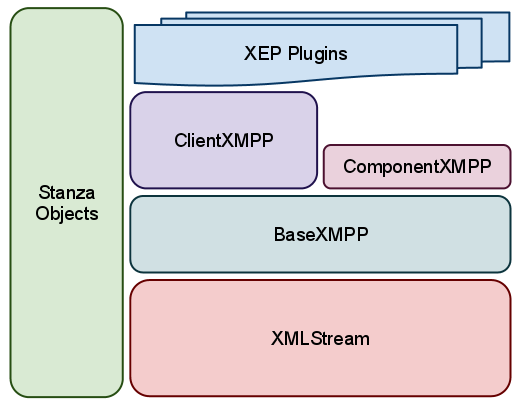Slixmpp Architecture¶
The core of Slixmpp is contained in four classes: XMLStream,
BaseXMPP, ClientXMPP, and ComponentXMPP. Along side this
stack is a library for working with XML objects that eliminates most
of the tedium of creating/manipulating XML.

The Foundation: XMLStream¶
XMLStream is a mostly XMPP-agnostic
class whose purpose is to read and write from a bi-directional XML stream.
It also allows for callback functions to execute when XML matching given
patterns is received; these callbacks are also referred to as stream
handlers. The class also provides a basic eventing system
which can be triggered either manually or on a timed schedule.
The event loop¶
XMLStream instances inherit the
asyncio.BaseProtocol class, and therefore do not have to handle
reads and writes directly, but receive data through
data_received() and write
data in the socket transport.
Upon receiving data, stream handlers are run
immediately, except if they are coroutines, in which case they are
scheduled using asyncio.async().
Event handlers (which are called inside stream handlers) work the same way.
How XML Text is Turned into Action¶
To demonstrate the flow of information, let’s consider what happens
when this bit of XML is received (with an assumed namespace of
jabber:client):
<message to="user@example.com" from="friend@example.net">
<body>Hej!</body>
</message>
Convert XML strings into objects.
Incoming text is parsed and converted into XML objects (using ElementTree) which are then wrapped into what are referred to as Stanza objects. The appropriate class for the new object is determined using a map of namespaced element names to classes.
Our incoming XML is thus turned into a
Messagestanza object because the namespaced element name{jabber:client}messageis associated with the classMessage.Match stanza objects to callbacks.
These objects are then compared against the stored patterns associated with the registered callback handlers.
Each handler matching our stanza object is then added to a list.
Processing callbacks
Every handler in the list is then called with the stanza object as a parameter; if the handler is a
CoroutineCallbackthen it will be scheduled in the event loop usingasyncio.async()instead of run.Raise Custom Events
Since a stream handler shouldn’t block, if extensive processing for a stanza is required (such as needing to send and receive an
Iqstanza), then custom events must be used. These events are not explicitly tied to the incoming XML stream and may be raised at any time.In contrast to stream handlers, these functions are referred to as event handlers.
The code for
BaseXMPP._handle_message()follows this pattern, and raises a'message'eventself.event('message', msg)
Process Custom Events
The event handlers are then executed, passing the stanza as the only argument.
Note
Events may be raised without needing stanza objects. For example, you could use
self.event('custom', {'a': 'b'}). You don’t even need any arguments:self.event('no_parameters'). However, every event handler MUST accept at least one argument.Finally, after a long trek, our message is handed off to the user’s custom handler in order to do awesome stuff:
reply = msg.reply() reply['body'] = "Hey! This is awesome!" reply.send()
Raising XMPP Awareness: BaseXMPP¶
While XMLStream attempts to shy away
from anything too XMPP specific, BaseXMPP’s
sole purpose is to provide foundational support for sending and receiving
XMPP stanzas. This support includes registering the basic message,
presence, and iq stanzas, methods for creating and sending stanzas, and
default handlers for incoming messages and keeping track of presence
notifications.
The plugin system for adding new XEP support is also maintained by
BaseXMPP.
ClientXMPP¶
ClientXMPP extends
BaseXMPP with additional logic for connecting
to an XMPP server by performing DNS lookups. It also adds support for stream
features such as STARTTLS and SASL.
ComponentXMPP¶
ComponentXMPP is only a thin layer on top of
BaseXMPP that implements the component handshake
protocol.